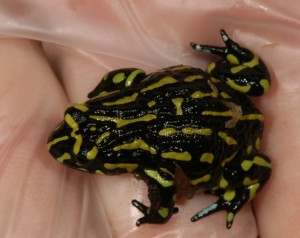 Species name: Pseudophryne pengilleyi
Species name: Pseudophryne pengilleyi
Common name: Northern Corroboree Frog
Red List status: Endangered (http://www.iucnredlist.org/apps/redlist/details/41050/0)
Distribution: New South Wales and the Australian Capital Territory, Australia.
Habitat: This species is found in sphagnum bogs, wet tussock grassland, wet heathland and the surrounding montane and sub-alpine woodland.
Threats to survival: The disease Chytridiomycosis is the primary threat to this species. Additional threats are climate change, habitat degradation, feral animals and weeds.
Reproductive behaviour: The male makes a terrestrial nest under tussocks or in the sphagnum moss above the edge of a pool or seepage line during summer, where multiple females may come to deposit eggs. The autumn rains or early snow melt flood the nest area, allowing the well-developed tadpoles to hatch and enter the pools.
Interesting natural history notes: This species has no known predators due to its toxic skin secretions. Not only does it obtain pumiliotoxins from its diet, the same alkaloid in the dendrobatid frogs of Central and South America, it also produces its own poisonous alkaloids, pseudophrynamines.
In situ projects currently underway: Annual monitoring of populations is undertaken. Additionally, research is currently underway to determine the impacts of various threats on the remaining populations..
Ex situ programs: A captive population has been established for this species with a large population at Tidbinbilla Nature Reserve (www.environment.act.gov.au) and a smaller population at Taronga Zoo (www.taronga.org.au). Reintroduction of captive-bred animals will occur in late 2010.
How can we help this species? The main way that one may contribute to the conservation of this species is by adopting a frog or donating to the in-situ recovery efforts at www.corroboreefrog.com.au







